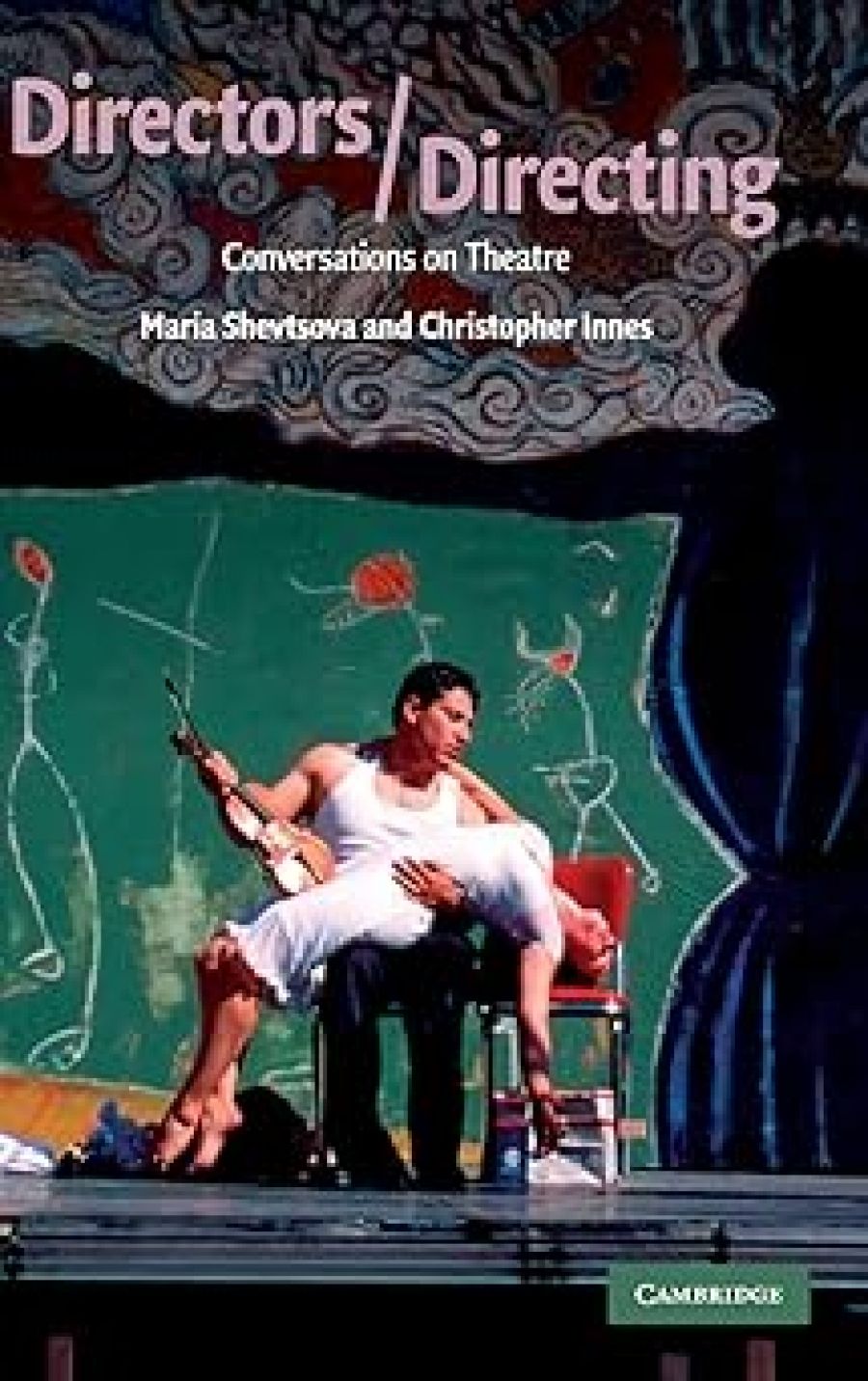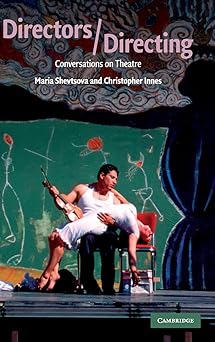
- Free Article: No
- Contents Category: Theatre
- Review Article: Yes
- Article Title: Portals and prosceniums
- Online Only: No
- Custom Highlight Text:
One view of the relationship between the word and the creative act is Goethe’s admonition: ‘Bilde Künstler, rede nicht’ – ‘Create, [the German word actually places more emphasis on the idea of shaping and forming than on artistic imagination] artist, don’t talk’. Typically, of course, his own Conversations with Eckermann (1823–32) show him frequently ignoring this precept, when the occasion (or the questioner) demands. And the last forty years have seen a proliferation of books in which actors, directors and designers talk – sometimes revealingly, sometimes unproductively – about their approach to the creative or re-creative act.
- Book 1 Title: Directors/Directing
- Book 1 Subtitle: Conversations On The Theatre
- Book 1 Biblio: Cambridge University Press, $150 pb, 279 pp
- Book 1 Cover Small (400 x 600):

One or two sensibly chosen interview questions addressed to, for example, Peter Brook or Robert Lepage will always throw up provocative and unexpected insights into both their working methods and their views on various dramatists: and having interviewed both these directors (along with others in the volume under review), I would suggest that the fluency and sharpness of the responses usually stand in inverse proportion to the artlessness of the questions. The interviewer’s task is inevitably made easier if he or she is dealing with someone whose ability to reflect on, and articulate his or her work process stands in some sort of dialectical relationship to the work itself. From the present volume, which comprises nine interviews with selected directors, along with brief introductions to their careers and a chronology of selected works, Lepage, Declan Donnellan and Lev Dodin are standout examples of theatre artists whose insights into plays and their own work processes match the quality of their productions, some of which have been staged at various Australian festivals over the past twenty years.
On the other hand, the book provides scattered instances of the other type of creative artist also described by Goethe: ‘Lord Byron is only great when he’s writing poetry; as soon as he reflects, he’s a child.’ In this connection, Peter Sellars’s comments on Shakespeare – ‘I’ve always thought Othello was a terrible play’ (apparently because it doesn’t let Desdemona ‘speak for her generation’) – are hardly instructive; which may explain why his recent production received such uncomplimentary reviews. And his suggestion that Shylock’s ‘Fair Sir’ to Antonio requires a day’s rehearsal calls to mind nothing so much as the Stephen Fry and Hugh Laurie sketch which devotes two pages to analysing ‘the ordinary spelling and the conventional and abstract sense of the word “Time”’ [emphases as in the original], to be delivered by the actor with a howl and ‘a gathering of the buttocks’.
Moreover, I have always been something of a sceptic about the work of the Wooster Group and its theatrical guru, Elizabeth LeCompte; the interview included here does nothing to dispel this scepticism. One of the more dispiriting experiences of my theatre-going life was a viewing of the disorienting, undermining, found materials-deploying (all terms used by the director) version of Three Sisters, renamed Brace Up! – presumably for reasons other than those which struck me, at the time, as entirely appropriate, viz. whole sections of the audience kept nodding off through boredom. As a theatrical experience, Brace Up! belonged in that category so neatly summarised by Stravinsky, who, speaking of an evening at Bayreuth, noted: ‘It was one of those productions where, after one and a half hours, you look at your watch and find that fifteen minutes have passed.’
In the interview included here, LeCompte’s answers range from the ineffably banal (‘the character, for me, in theatre, is the text and the persona of the person’) to the frankly ludicrous. Apropos her version of Racine’s Phèdre which featured as an essential production element ‘perpetual enemas’ (the temptation to gloss this must be resisted), she discloses that ‘asshole’ wasn’t a ‘central metaphor’, but ‘just asshole. As a portal ... rather than vagina.’ (Sans blague, as Racine’s countrymen might say). This is the sort of observation which, if it belongs anywhere, should appear in Private Eye’s ‘Pseuds’ Corner’.
However, such instances of frightening-the-horses infantilism are not representative of the book, which, apart from the LeCompte interview, is notable for its marriage of responsive interlocutor with probing and engaging questioner. Christopher Innes’s exchanges with Lepage and Max Stafford-Clark, and Maria Shevtsova’s with Donnellan and Dodin, are outstanding examples of how smartly chosen questions can elicit responses from theatre practitioners which contain more insights than any number of dutifully researched academic papers. A question to Lepage about the use of metaphors and (not just technical) resources in his work prompts some telling and acute description and analysis of the relationship between textual and imagistic elements in his productions (he is speaking here primarily of the group-devised productions which tend to be his major focus):
I improvise with hours and hours of dialogue ... but, at the same time, we do explorations with objects ... And these are not connected ... There’s a moment where all these kinds of ideas, whether they’re textual or imagistic, naturally and eventually, connect ... So you could cross off that dialogue because the image says it better. Other things are better said spoken, so this image is redundant ... It’s trial and error and it’s also part of a big game where you just kind of connect pieces of puzzle; and when you try to force them they don’t work. It’s really like sculpting.
Anyone who has seen a Lepage production will recognise immediately this magical aspect to his work: moments when text and image collide or connect, and when the director fashions images so compelling and expressive that they stay in the mind – a set of shoeboxes representing houses on a Canadian Street (The Dragons’ Trilogy); a table divided down the middle, rocking and dipping, as a tiny sailing ship traverses its surface before toppling over one side (the storm which opens The Tempest.)
Although anyone who has seen a Donnellan production can attest to the strong visual aspect of his work (reinforced by his long-time collaborator, the designer Nick Ormerod), the director is more concerned with staging established texts – notably Shakespeare – than is Lepage. Donnellan has a formidable theatrical intelligence, and has written possibly the best book on acting published in the last twenty years – The Actor and the Target (2002). Here, alongside the interview’s casually proffered insights ( ‘I’m completely fascinated by the fact that [Shakespeare] never writes the play that everybody else was writing, with an evil Cardinal and a Spanish/Italian Catholic court, which were so popular at the time’), there is a solid awareness of the practicalities of theatre work. Speaking of the last scene of Cymbeline, he moves from a particular observation on how the problem should be addressed to a general comment on working in the theatre:
We are still working on it to experience ... what it might be like to see for the first time somebody whom you love – a brother or sister whom you have loved, or a father whom you have loved but never seen. It’s an ongoing process, but it’s not an intellectual process. In many respects, it’s a rather anti-intellectual process because sometimes our intellects are not very useful, especially when they give us preconceptions. We have to meet the world as it really is, not as we intellectually perceive it ought to be.
Like Brecht’s maxim for the theatre (‘The truth is concrete’), this last sentence might well stand as a guide for all aspiring actors and directors.


Comments powered by CComment